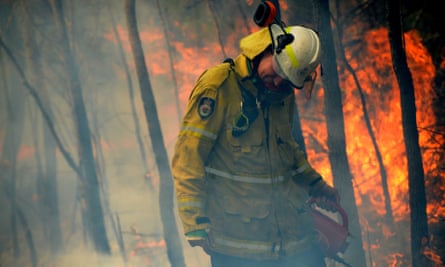Extract from The Guardian
Report
finds climate change ‘clearly played a role’ in conditions that led up
to Australia’s 2019-2020 fires, which were so extreme, traditional
firefighting methods often failed.
Last modified on Tue 25 Aug 2020 15.25 AEST
Last summer’s bushfire disaster was so unusual that traditional firefighting methods, such as hazard reduction burning, failed in some instances, an inquiry into the crisis heard.
The final report of the New South Wales bushfire inquiry, published on Tuesday, said the 2019-20 bushfire season brought fires in forested regions on a scale not seen in recorded history in Australia.
“The season showed us what damage megafires can do, and how dangerous they can be for our communities and firefighters,” the inquiry chairs, former NSW police deputy commissioner Dave Owens and former NSW chief scientist Mary O’Kane, said in their opening summary.’
“And it is clear that we should expect fire seasons like 2019-20 or potentially worse to happen again.”
The NSW government said on Tuesday it would be adopting all of the report’s 76 recommendations, which include the establishment of a major new centre for bushfire research and technology, new training to increase the capacity of fire authorities to deal with disasters of the scale seen in 2019-20, and examination of existing preparedness strategies to determine the best approach to increasingly frequent, extreme fire seasons.
The inquiry found climate change and rising greenhouse gas emissions “clearly played a role in the conditions that led up to the fires and in the unrelenting conditions that supported the fires to spread” but climate change alone “does not explain everything that happened”.
“The 2019-20 bush fire season challenged conventional assumptions. For example, it appears that the extreme dryness of forested regions over large continuous areas was the determining factor in the size of the fires,” it read.
The report said that extreme conditions of the kind seen last summer are likely to happen again and dangerous fires will become more frequent, meaning state and local authorities would need to do more to prepare.
Former fire chiefs who have called for an urgent response from governments to the climate crisis said the findings of the review supported their position.
During the fire season, former fire chiefs from several states said their advice to the Morrison government that the climate crisis was making fire seasons worse had been ignored.
“The NSW bushfire inquiry has echoed what the experts have said all along: climate change is driving longer, hotter and more dangerous bushfire seasons, including our Black Summer,” said Greg Mullins, a former fire and NSW rescue commissioner.
Mullins said Australia was in a new era of climate-driven bushfires in which fires were more likely to develop dangerous pyroconvection events. He said governments needed to do more to address the underlying cause.
“Immediate steps the NSW state government can take to drive down emissions include: rejecting all new coal and gas projects like Santos’ Narrabri project, and accelerating its net-zero plan to create clean, long-term jobs in sectors like renewable energy,” he said.
The report said the scale of the disaster meant fire services were stretched in their capacity to respond, even with interstate and international support. Authorities could not get to all fires fast enough and fires started by lightning in remote areas made suppression difficult.
The inquiry found the total tally of fire-generated thunderstorms in south-eastern Australia since the early 1980s until 2018-19 was 60. That number jumped to 90 by the end of the last summer, an increase of 50% in a single fire season.
Taken together with dangerous weather conditions, the fires had become extreme, rendering some traditional fire-fighting methods ineffective.
“Previous prescribed burning and hazard reduction activity appears to have reduced fire spread in some instances, but in others it appears to have had no effect on the severity of the fires,” the report said.
It also found that the 2019-20 season could have been even worse if conditions had combined to affect more population centres or if the drought had not caused a decline in grass fuel loads.
In the face of such megafires, governments, authorities and communities needed to know more about fire suppression methods and how effective they were, the report added.
The authors also recommended immediate improvements to communications in fire-prone communities, safety equipment and systems for firefighters, increased aerial firefighting at night and a reexamination of traditional firefighting techniques, including backburning.
The NSW premier, Gladys Berejiklian, said on Tuesday the scars left by the fires season would be long-lasting.
“We’re not going to pretend that we have managed firstly to deal with all the physical issues and secondly, of course, the ongoing trauma of those directly impacted and, of course, those who have lost loved ones,” she said.
“That is why the government is there to continue to support those communities but I also appreciate very much that there is a sense of urgency and the next fire season is already upon us.”

She said the government had taken every action it could to respond to the recommendations and the emergency services minister, David Elliott, would be tasked with coordinating the government’s response and any measures that could be expedited.
“We have to accept also our climate is changing and those who wrote the report acknowledge that,” she said.
“Coupled with the drought, coupled with fuel loads in some areas but, moreover, the climate is changing.
“We have to expect and accept that part of the ferocity we saw was a combination of all those things and our government is working as hard as we can, as fast as we can and as efficiently as we can to resource up our agencies but also to do everything we can to mitigate the risks.”
No comments:
Post a Comment